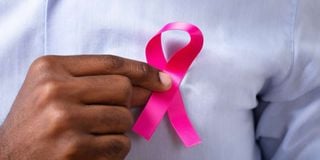To tackle NCDs, we must increase funding

A man's hand holding a pink ribbon supporting breast cancer awareness..
What you need to know:
- The problem with breast cancer is that it tends to be diagnosed too late for treatment, a situation that describes 60 to 80 per cent of all cases.
- The National Cancer Control Strategy 2017-2022 ranks cancer as the third leading cause of death after infectious and cardiovascular diseases.
As we come to the end of the Breast Cancer Awareness Month, it’s apt to reflect on the malignancy. For, not only does the disease take a huge toll on patients and caregivers, but it’s also important to appraise Kenya’s scoreboard in regard to handling non-communicable diseases (NCDs).
First the toll. No other book I’ve read speaks to the breast cancer tragedy as Baptist pastor John Gichinga’s “Cry of the Heart”, which captures Emmy Gichinga’s battle with the disease from the moment the university professor was diagnosed to her death nine months later. That it was traumatic for Emmy to lose her breast through a mastectomy, and later her hair, goes without saying. And yet, his wife’s condition was equally harrowing to the pastor, who did not know how to react to his significant other without her breast and her hair—primary symbols of femininity.
A friend on chemotherapy clean-shaved the little that was left of her beautiful hair to symbolise coming to terms with her condition. It shows that unless Emmy explained her decision not to wear a headscarf as per the good pastor’s suggestion, both would have been caught up in an emotional roller-coaster that defines the mental state of patients and caregivers.
The problem with breast cancer – as with most cancers – is that it tends to be diagnosed too late for treatment, a situation that describes 60 to 80 per cent of all cases.
The National Cancer Control Strategy 2017-2022 ranks cancer as the third leading cause of death after infectious and cardiovascular diseases. Among the conditions related to NCDs, cancer is the second leading cause of death, accounting for 7 per cent of overall national mortality. The annual incidence of cancer is close to 37,000 new cases with an annual mortality of over 28,000. Breast cancer is the leading type of cancer in Kenya, with about 6,000 new cases diagnosed every year and 2,500 deaths.
Cancer patients
The Ministry of Health has established a number of county-level chemotherapy centres and provided diagnostic equipment in addition to facilities available in referral hospitals. But constraints in tackling cancer remain. These include inadequate care infrastructure and financial difficulties. A whopping Sh377.1 billion is needed to implement the NCDs strategic plan, yet only 6 per cent of this (Sh20.7 billion) is available. This funding shortage affects all the NCDs, breast cancer included.
Mr David Makumi, the vice-chairman of the NCD Alliance of Kenya, considers the funding gap as a reflection of the lack of political will.
Having been part of the team that crafted the NCD Strategic Plan, and bearing in mind his high profile in the National Cancer Institute, Mr Makumi’s concern should worry Kenyans.
“We launched a document that is costed and we know how much is needed to fight these diseases. But once you launch and you’re not saying you will put this amount into it, [then] we’re just going to live to our reputation of having good documents gathering dust,” he said.
Mr Makumi calls for a mobilisation of resources similar to the fight against Covid-19.
It is lamentable that the National Hospital Insurance Fund provides only Sh25,000 per patient towards cancer care, whose cost of management is way higher. Many cancer patients cannot complete the prescribed course of treatment because they run short of money and have to resort to fundraisers.
The writer is consultant revise editor for the Daily Nation




